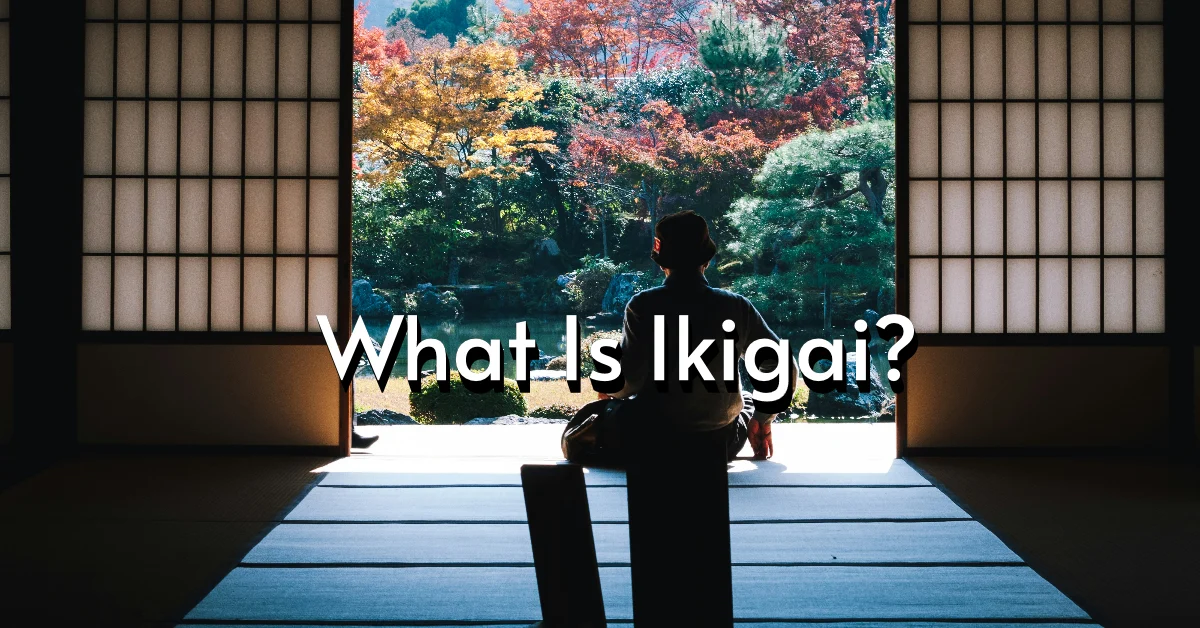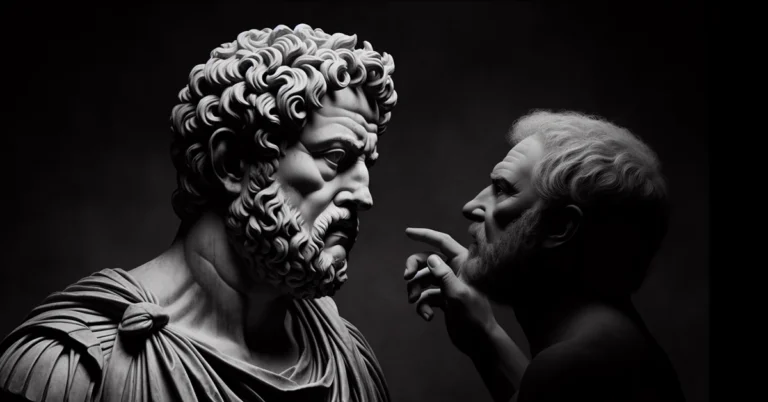Why the World Needs Ikigai Now More Than Ever
In a world where people are constantly asking “What should I be doing with my life?”, ikigai offers something rare: stillness, direction, and meaning, without the pressure. It’s not a productivity tool. It’s not about chasing more. It’s about aligning your inner world with the way you live.
The beauty of ikigai lies in its simplicity: it invites you to stop running and start living with intention. Let’s break it down.
Ikigai Meaning in English
At its core, ikigai is a Japanese word made up of two parts:
“Iki” (生き) — meaning life
“Gai” (甲斐) — meaning value, worth, or reason
Put together, ikigai means “a reason for living” or “value in life.” But don’t mistake its elegance for vagueness. Your ikigai is the invisible thread tying your daily actions to your deeper meaning. It’s what keeps you going when things get hard.
Ikigai Can Be Best Defined As…
The best modern definition?
Ikigai is your reason to wake up with meaning, even when the day ahead isn’t perfect.
There is a similarity to Stoicism Philosophy. It’s the thing you’d do even if no one were watching. It’s the spark you protect when life gets noisy. It could be raising a family, painting after work, helping others, teaching, solving problems, or simply walking your dog while the sun rises.
Your ikigai doesn’t need to impress anyone. It just needs to make you feel alive.
What Is the Concept of Ikigai?
The traditional Japanese lens on ikigai isn’t about achieving success. It’s about embodying balance.
In Okinawa—where people live the longest, healthiest lives in the world—ikigai is woven into everyday life. They don’t rush. They don’t multitask. They don’t chase careers just for status. Instead, they live in sync with what matters: community, contribution, movement, and purpose.
Ikigai teaches us that:
A meaningful life isn’t about doing everything—it’s about doing the right things
Fulfillment comes from simplicity, not excess
Purpose can be small and quiet, not loud and performative
This philosophy gently reminds us that we don’t need to escape our lives—we need to reconnect with them.

Where Did Ikigai Come From?
Before ikigai became a buzzword on book covers and podcasts, it was simply how people in rural Japanese communities lived. A quiet, intentional rhythm to life.
And it worked. Especially in Okinawa, home to some of the longest-living, happiest people on Earth.
Let’s trace ikigai back to its roots and see why it’s so much more than a trend. It’s a life manual, passed down without needing a name.
Is Ikigai Japanese?
Yes—ikigai is deeply Japanese. But not in the flashy, hypermodern Tokyo sense. It comes from a slower, simpler Japan—the kind you find in the villages of Okinawa, where people garden, walk, and gather for morning chats under the sun.
Okinawa has the highest concentration of centenarians (a person who has reached the age of 100 years or older) in the world, and when researchers looked into why, they kept finding one word on everyone’s lips: ikigai.
But it’s not about long life for the sake of it. It’s about a life worth living—every single day.
In Japan, ikigai isn’t something you chase. It’s something you notice. It could be caring for your grandchildren. Sweeping the same garden path every morning. Making tofu with your bare hands like your father did.
Ikigai is cultural, emotional, and practical all at once—and that’s what makes it endure.
Who Discovered Ikigai?
Trick question: No one did.
Because ikigai wasn’t invented—it evolved.
There’s no single philosopher or monk behind it. No official text. No “guru.”
Ikigai came from lived wisdom—the kind that forms when generations quietly observe what makes life worth living and pass those lessons down without needing to write them.
It’s a philosophy that wasn’t taught in schools but was lived at the kitchen table, in the rice fields, at the community center.
No hype. No hustle. Just consistent alignment between joy, usefulness, and contribution.
That’s why ikigai is so powerful.
It’s not someone else’s system—it’s something you’re allowed to define on your own.
The Ikigai Framework
How It Works
Finding your purpose sounds beautiful until you’re staring at a blank page, wondering what you’re even good at. That’s why the ikigai model exists. It doesn’t give you the answers. It helps you ask the right questions.
Think of it as your life tip guide—a visual framework for figuring out why you’re here, what you’re meant to do, and how to live like it matters.
The model is simple but surprisingly deep. And if you’ve ever thought, “I want to build a life I love, but where do I even start?”—this is your blueprint.
What Is the Ikigai Theory?
At the heart of the ikigai theory lies a four-part Venn diagram or Ikigai diagram.
It maps out the intersection of:
What you love
What you’re good at
What the world needs
What can you be paid for
Your ikigai sits right in the middle.
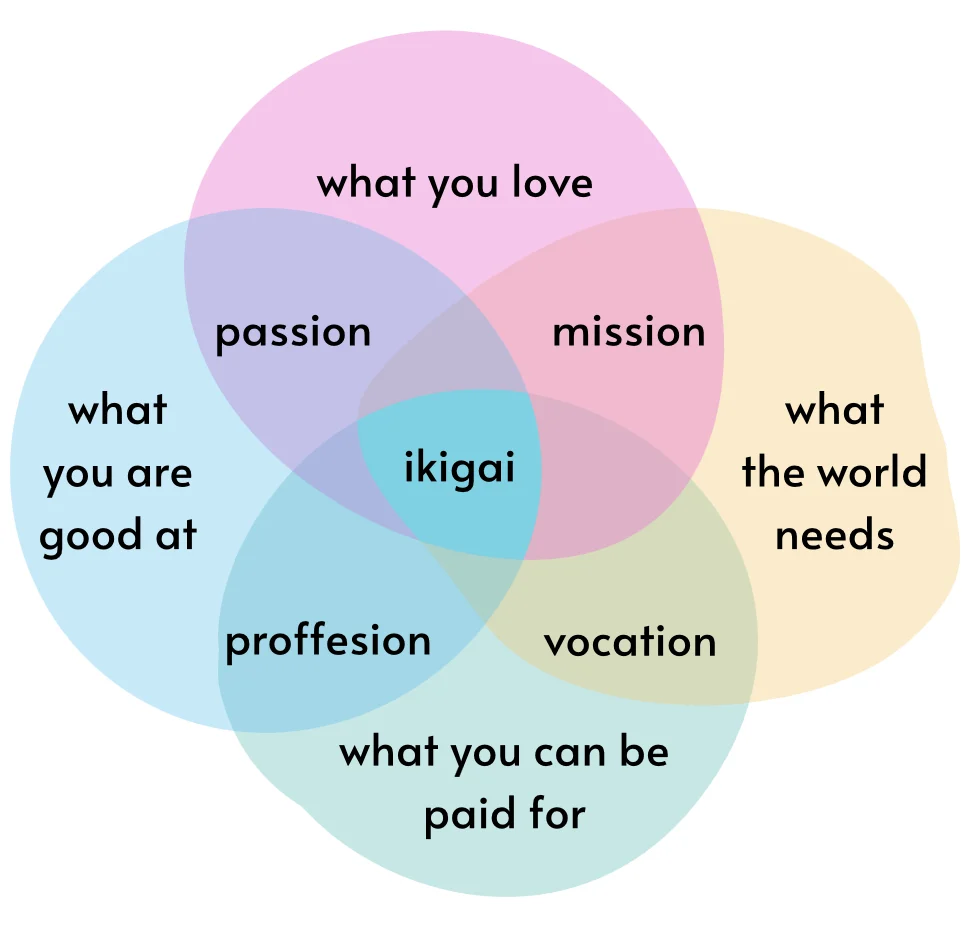
It’s not just about passion. It’s not just about money. It’s not just about service. It’s about integration, where your inner world meets outer contribution.
Here’s what happens when the pieces don’t align:
Do what you love but don’t get paid → joyful, but broke
Do what you’re good at but hate → successful, but empty
Do what the world needs but lack skills → well-meaning, but burned out
Do what pays but feels meaningless → stable, but soul-starved
The ikigai theory helps you balance all four so you’re not choosing between purpose and practicality. You’re building a life that feels right and works in the real world.
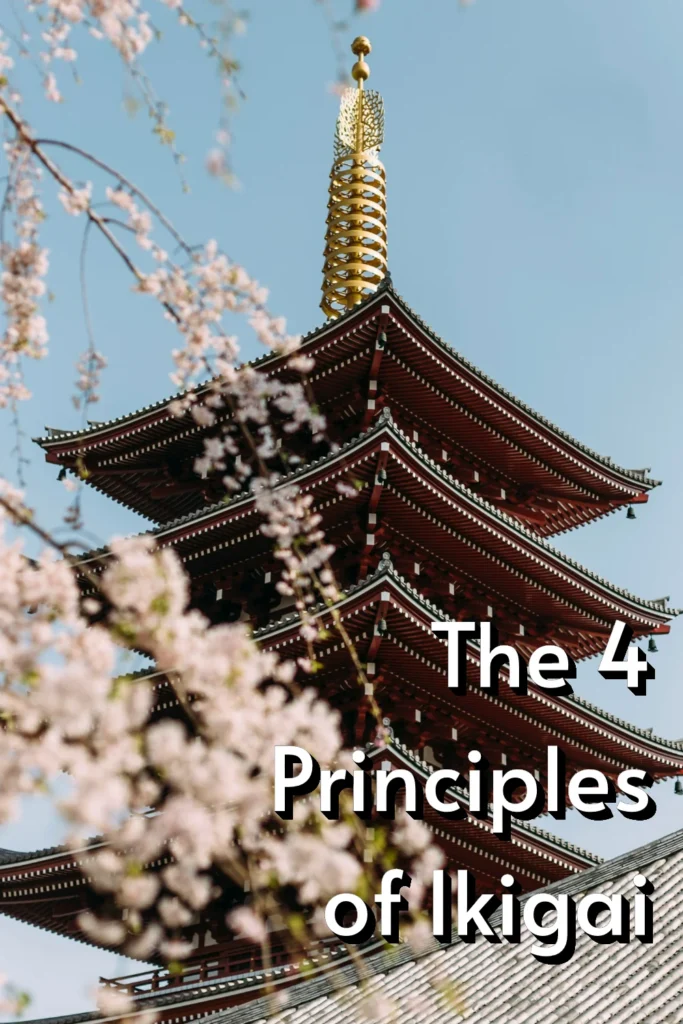
The 4 Principles of Ikigai: A Guide to Life Fulfillment
Within the ikigai model, there are four key zones—each representing a pillar of a meaningful life. Let’s break them down:
Passion – What you love + what you’re good at
This is your spark. The thing you lose track of time doing.
Mission – What you love + what the world needs
Your calling. The purpose that pulls you toward service.
Vocation – What the world needs + what you can be paid for
Your societal role. Where your work adds real-world value.
Profession – What you’re good at + what you can be paid for
Your skillset. Your career, your expertise, your economic engine.
When you understand these zones, you’re no longer asking “What job should I get?”
You’re asking:
“How do I build a life around what matters to me, and serves others too?”
The goal isn’t to obsess over achieving perfect balance, but to move closer to the center, day by day.
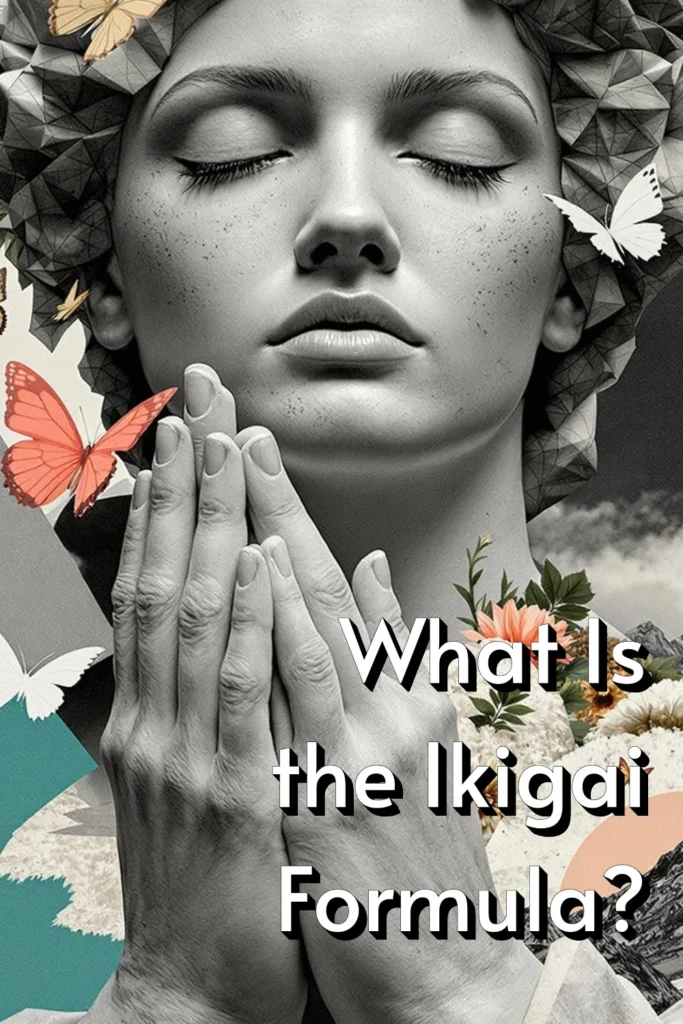
What Is the Ikigai Formula?
If you’re in a life transition—changing careers, feeling lost, or trying to get your life back on track—ikigai coaching is one of the most grounded ways to find clarity.
Here are three life manual tips from the coaching world that align perfectly with the ikigai model:
Audit Your Life Roles
List what you do daily: career, relationships, habits.
Which of them feels aligned with what you love and what you’re good at?
Where are you overgiving with no joy in return?
Look for Energy Patterns
After each day, ask: What gave me energy? What drained me?
These answers will always point toward your mission or vocation.
Design Tiny Purpose Habits
Don’t chase a perfect life overnight. Start by adding purpose to your current life.
Ten minutes of something meaningful per day is better than waiting for a life overhaul.
You don’t need to quit your job or move to a mountain in Japan.
You just need to start living with alignment—even in the small stuff.
Because that’s what ikigai is:
Tiny joys. Meaningful actions. A life built around what matters.
How to Start Over Using the 7 Rules of Ikigai
Sometimes, the only way forward is to start over —not by burning your life down, but by slowly clearing out what no longer serves you. And that’s exactly where the 7 rules of ikigai come in.
These aren’t surface-level life tips. They’re philosophical anchors—a guide to life that’s simple, ancient, and surprisingly effective in our overstimulated, overwhelmed world. If you’ve ever felt like you’re drifting, burnt out, or constantly running toward “someday” happiness, consider this your reset point.
This is how you start over with intention, without losing yourself.
What Are the 7 Rules of Ikigai?
Here are the 7 foundational rules—drawn from Okinawan wisdom, lived by centenarians, and now adopted around the world by those looking to build a life they love.
1. Stay Active, Don’t Retire
Your soul doesn’t retire. And neither should your curiosity.
This doesn’t mean working forever. It means always having a reason to move, think, create, or serve. Even small hobbies—like gardening, writing, or volunteering—can keep you mentally and emotionally alive.
Ikigai tip: Plan your life like it has chapters, not an ending.
2. Take It Slow
Slowness is not laziness—it’s presence.
Rushing through life means you’re constantly missing it. Slowing down allows your mind to rest and your emotions to catch up. Even your purpose can’t reach you if you’re moving too fast to feel it.
Ikigai tip: Protect white space on your calendar. Don’t glorify busy.
3. Don’t Fill Your Stomach
This is where the 80% rule comes in. But it’s more than diet—it’s mindset.
We’ll go deeper on this in a moment, but the short version: satisfaction isn’t about more. It’s about knowing when to stop and savor.
Ikigai tip: Consume everything—food, media, conversations—with mindfulness.
4. Surround Yourself with Good Friends
Connection is medicine.
Loneliness is poison. Create space for laughter, honesty, and emotional safety. Not everyone earns a front-row seat in your life, but those who do? Hold them close.
Ikigai tip: Schedule connection the way you schedule appointments.
5. Get in Shape for Your Next Birthday
Not for vanity—for vitality.
This is about treating your body as a partner, not an afterthought. Move it, fuel it, rest it, respect it. No six-pack required. Just consistency and care.
Ikigai tip: Choose movement that makes you feel good, not punished.
6. Smile
Not the fake “everything’s fine” smile. The real one. The soul-smile.
Gratitude can’t fix everything, but it softens the hard stuff. A simple smile—at yourself, at strangers, at the sky—reminds your nervous system that you’re safe, even when life feels shaky.
Ikigai tip: Smile with your eyes first. The rest follows.
7. Reconnect with Nature
The outside world heals your inside world.
Nature doesn’t rush. It just is. The trees, the wind, the ocean—they model balance and resilience without saying a word. You don’t need a forest. A short walk, a breeze on your skin, or soil in your hands will do.
Ikigai tip: Your life story isn’t just digital. Root it in the physical world.
What Is the 80% Rule in Ikigai?
This rule—“Hara hachi bu”—comes straight from Okinawan culture. It means:
“Eat until you’re 80% full.”
But this idea goes beyond food. It’s one of the most powerful lessons in positive intelligence and emotional regulation.
In a world that glorifies more—more success, more followers, more productivity, ikigai teaches you to leave space.
Here’s how the 80% rule applies across your life:
1. Eat Light, Feel Light
Overeating dulls your energy, focus, and even your emotional clarity. Eating until you’re almost full sharpens your senses and keeps your body in balance.
Life tip: Eat slow enough to feel satisfied before you feel stuffed.
2. Think Light, Live Clear
Stop overconsuming information. Not every notification needs your attention. Not every thought needs to be entertained.
Create mental white space so your real thoughts have room to breathe.
Life tip: Decluttering your life starts with your attention, not your closet.
3. Want Less, Enjoy More
When you stop chasing the next dopamine hit—more money, more stuff, more praise—you start to actually enjoy what you already have. This is where fulfillment lives.
Life tip: Replace “What’s missing?” with “What’s enough?”
4. Respond Gently, Not Excessively
You don’t have to react to everything. 80% calm, 20% fire is a solid life ratio. This helps you respond with clarity instead of reactivity.
Life tip: Breathe before reacting. That pause is power.
When you embrace the 80% rule, you’re not restricting your life. You’re refining it.
You’re creating room for clarity, joy, energy, and meaning.
And maybe that’s the whole point of starting over:
Not to do more. But to do less, better.
How to Find Your Ikigai
You don’t “find” your ikigai by overthinking it or waiting for lightning to strike.
You uncover it by paying attention. By practicing presence. By asking better questions—not to others, but to yourself.
This is where positive intelligence comes into play. It’s not about toxic positivity. It’s about mental clarity. The ability to separate your inner critic from your inner compass.
And once you start asking the right questions?
You don’t just figure out what to do with your life—you begin to build a life you love.
What Is My Ikigai?
Your ikigai is already inside you.
It’s just buried beneath obligations, distractions, and the fear of choosing wrong.
So instead of searching externally, start here—with these real questions:
1. What did you used to love before life got loud?
Before bills, burnout, and broken plans—what lit you up? That spark still exists.
2. What do people naturally come to you for?
Advice, encouragement, solutions, support, creativity? This points to your gifts.
3. What problems in the world do you actually care about solving?
Forget what sounds impressive. What moves you?
4. What activity makes you lose track of time?
Flow = alignment. Where there’s flow, there’s purpose.
5. What would you still do if no one praised you for it?
This is your true north. It’s not about applause. It’s about aliveness.
Write these down. Sit with them.
Because your ikigai doesn’t arrive in a single sentence. It arrives in patterns.
Clues. Themes. Repetition. And once you notice them, your direction becomes clear—even if the path still feels fuzzy.
How Do I Practice Ikigai Daily? - A Mini Life Manual
It’s easy to treat ikigai like a feel-good concept you read about once and forget.
But the real magic? It starts when you turn this philosophy into practice.
Here’s your mini life manual—small habits that support your ikigai without overcomplicating it:
1. Begin Your Morning with Intention
No phone. No rush. Just one quiet moment. Ask:
“What would make today feel meaningful—not just productive?”
2. Move Your Body with Purpose
Not to punish it. But to honor it. Walking, stretching, yoga, tai chi—simple motion unlocks mental clarity.
3. Create a Gratitude Anchor
List 1–3 things daily that brought you joy or peace.
Ikigai isn’t always grand. Sometimes it’s that cup of tea. That clean page. That unexpected laugh.
4. Give Something Every Day
Time, wisdom, kindness, energy. Contribution is a core part of your life purpose.
And it doesn’t have to be big to matter.
5. Protect Your Energy
Not everything deserves your attention. Not everyone deserves access.
Positive intelligence means choosing what feeds you—not drains you.
6. End the Day with a Story, Not a Score
Don’t rate your day based on output. Reflect on what felt true.
Ask: “Did I do something today that made me feel alive?”
You don’t need a new life. You need new rhythm.
One that’s built on presence—not performance.
Finding Your True Purpose with the Ikigai Model
The ikigai model isn’t a test you pass or a title you earn.
It’s a mirror—one that reflects who you’ve always been beneath the noise.
Let’s connect the dots.
When your answers from earlier start to align with the model—
What you love
What you’re good at
What the world needs
What can you be paid for
You’ll start to feel it. Less confusion. More clarity.
Here’s a short story to anchor this:
A man was stuck in a high-paying job he hated. On weekends, he built furniture in his garage just to decompress. Over time, friends started asking for pieces. He never planned to quit his job—but eventually, his side craft became his main calling.
He didn’t chase passion. He followed peace. And that led to purpose.
Your ikigai won’t always show up loud.
It might whisper.
But once you hear it—you’ll know.
Because your ikigai is the intersection between who you are, what you do, and why it matters.
Is Ikigai for You?
Who Should Read This Japanese Life Guide?
Here’s the good news: Ikigai doesn’t care how old you are, how broken you feel, or how “off-track” your life seems.
It doesn’t require a midlife crisis, a dramatic retreat to a mountain, or a career shift.
It meets you exactly where you are.
Whether you’re rebuilding from burnout, exploring who you want to be, or simply trying to start over with more meaning, ikigai is your quiet, steady compass. It’s one of those rare lifestyle books that speaks across generations.
Let’s break down exactly who this philosophy was made for.
Can Teens and Kids Read Ikigai?
Absolutely—and honestly? The earlier, the better.
When young people are exposed to the concept of ikigai, they begin building emotional intelligence early. It helps them:
Develop intrinsic motivation, rather than chasing validation
Understand the importance of small daily joys
Explore the difference between doing something they’re good at vs. doing something they love
Learn how to make decisions based on alignment, not pressure
Instead of telling kids they need to figure out what they want to be, we can start asking:
“What do you love doing that makes you feel useful, happy, and alive?”
This isn’t just philosophy. It’s a life guide—one that helps teens and even kids start forming a stronger inner compass.
Whether you’re a parent, teacher, or mentor, introducing ikigai to a young person can be one of the most empowering tools you give them.
Who Should Read Ikigai?
If your first instinct was “Probably not me,” you’re exactly who this is for.
The people who benefit the most from ikigai are usually the ones feeling:
Stuck in the grind
Burned out by success that doesn’t feel fulfilling
Unsure what their next chapter looks like
Like they’re checking boxes but still feel lost
Or—curious but overwhelmed by how to start figuring it out
This guide isn’t about telling you what to do.
It’s about helping you reconnect with what matters—so you can do less of what drains you and more of what feels aligned.
Ikigai is for the dreamers who forgot how to dream.
The doers who don’t know why they’re doing anymore.
And the seekers who want to live—not just exist.
Whether you’re 17, 37, or 77—this life style book will meet you at the doorway to your next version of self.
Which Ikigai Book Should You Read First?
The most well-known—and most recommended—is:
“Ikigai: The Japanese Secret to a Long and Happy Life” by Héctor García and Francesc Miralles
It’s short, elegant, and practical. You’ll walk away with:
A clear understanding of the ikigai model
The 7 lifestyle principles from Okinawan elders
Real stories of people living with purpose into their 90s and beyond
If you want to go deeper—or explore other life philosophy books that pair beautifully with ikigai—try:
“Happiness Becomes You” by Tina Turner
A soulful book on inner peace, resilience, and purpose through Buddhist principles.
“The Great Work of Your Life” by Stephen Cope
A deep dive into dharma—the Indian parallel to ikigai—using stories of real people pursuing meaning over ambition.
Together, these books form a modern life manual—a toolkit to help you stop living on autopilot and start building something meaningful.
The Deeper Meaning - Why Ikigai Still Matters
If you’ve ever stared at the ceiling wondering, “What am I even doing with my life?”—you’re not alone.
The answer is what most people are too afraid to admit out loud.
Ikigai won’t give you a one-size-fits-all answer.
But it will give you the right lens. A way to look at your life—not as something to escape or fix—but as something to align.
It’s not about chasing the perfect job or finding some hidden talent.
It’s about reconnecting with what makes you feel useful, grounded, and alive.
Why Ikigai Is Important in a Modern World
Let’s call it what it is: we’re living in the age of emotional noise.
Burnout is normalized. Overthinking is celebrated. And somehow, if you’re not optimizing every second of your life, you’re “wasting time.”
That’s exactly why ikigai matters now more than ever.
Because while modern life shouts “Do more!”, ikigai whispers:
“Do what matters.”
This Japanese life philosophy helps you:
Combat burnout by shifting your energy from constant output to meaningful input
Break free from overthinking by anchoring to values, not just decisions
Tune out external pressure and listen to what makes you feel alive
Unlike productivity hacks that tell you to squeeze more into your day, ikigai tells you to strip away the noise and focus on the intersection of joy, skill, service, and sustainability.
In other words, it doesn’t just help you find what to do with your life.
It helps you find why you’re doing it in the first place.
Is Ikigai Good or Bad?
If you’re looking at ikigai like it’s a career shortcut or a “life purpose” formula to help you get rich fast, you’re missing the point entirely.
Ikigai isn’t about hacking your way to fulfillment.
It’s not a to-do list.
It’s not a business plan.
It’s not a self-help trend.
It’s a philosophy. A mindset. A quiet commitment to live in alignment, not acceleration.
Too many self-development trends today treat life like a math equation:
Do this → Get that
Hustle harder → Win bigger
Find purpose → Achieve more
But ikigai flips the entire script.
It asks you:
What lights you up when no one’s watching?
What would you still do if success weren’t guaranteed?
What makes you feel grounded, not just productive?
It’s not about more. It’s about meaningful.
And that’s what makes ikigai good, not as a hack, but as a compass.
The Ikigai Code - How to Plan Your Life with More Meaning
So what does all this look like in real life?
Let’s break it down into a practical mindset—something I call “The Ikigai Code.”
This isn’t a checklist. It’s a way to approach your days, your choices, and your life’s direction with calm, clarity, and courage.
1. Design a life that feels good, not just looks good
Purpose isn’t always Instagrammable. Sometimes it looks like silence, simplicity, or an unglamorous contribution.
2. Prioritize energy, not just achievement
If something drains you—even if you’re “good at it”—it’s not aligned.
Plan your life around energy gainers, not just performance metrics.
3. Practice emotional intelligence, not just task management
Know when you’re triggered, tired, or disconnected—and pivot. Your mood is a compass. Trust it.
4. Align your calendar with your values
If your time doesn’t reflect what you care about, your life eventually won’t either.
This is where meaning lives.
5. Check in with your inner compass—weekly
Ask yourself: “Did I do something this week that made me feel useful, joyful, or alive?”
If not, adjust. Gently, but honestly.
This is the ikigai approach to lifestyle design.
It’s not about perfection. It’s about direction—slow, steady, meaningful.
And when you live this way, you don’t just figure out what to do with your life.
You start to feel like your life is finally yours again.

